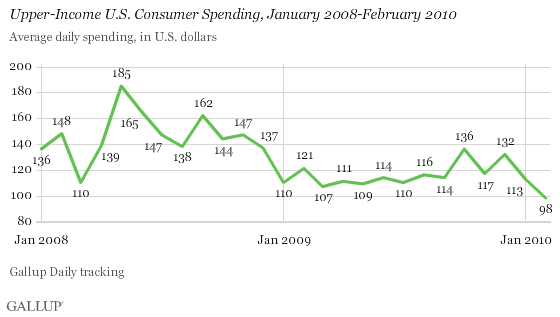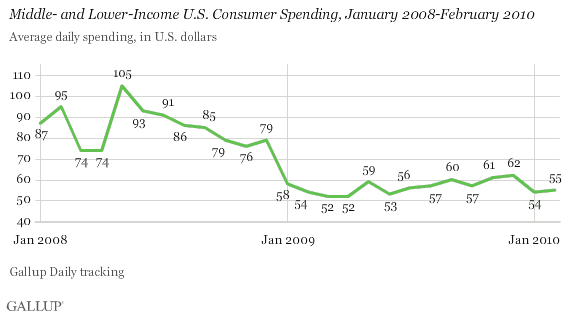PRINCETON, NJ -- Snowstorms, a declining stock market, and the new normal combined in February to drive upper-income Americans' self-reported spending to its lowest level since Gallup began Daily tracking more than two years ago. Upper-income households (those making $90,000 or more a year) reported spending an average of $98 per day in stores, restaurants, gas stations, and online in February -- down 13% from January's $113, down 19% from the $121 average of a year ago, and down 34% from $148 in February 2008.

Middle- and Lower-Income Spending Flat
"While Wall Street may have been encouraged last week by better-than-expected chain-store sales, upper-income consumers report spending less on average in February than in January."
In contrast to their upper-income counterparts, middle- and lower-income Americans (those making less than $90,000 a year) reported spending an average of $55 per day in February -- on par with January ($54) and unchanged from February of last year ($54), but down 42% from $95 in February 2008. While the snow probably reduced these Americans' spending in malls and other stores, last month's high gas prices compared with those from a year ago may have driven up spending.

Upper-Income Spending Is Needed
While Wall Street may have been encouraged last week by better-than-expected chain-store sales, upper-income consumers report spending less on average in February than in January, which is in line with economists' expectations that Friday's retail sales report will show a decline for last month. While some upscale retailers may have seen some modest improvements in their February sales and regained some market share from their competitors, Gallup's data suggest that upper-income Americans are still pulling back on their discretionary spending -- continuing a trend from last year.
The current consumer psychology is related in part to the jobs crisis, but Gallup's analysis suggests its impact on upper-income spending is considerably less than on middle- and lower-income spending. Similarly, $80-a-barrel oil and the resulting much higher gas prices this year compared with last are having a similarly disparate impact on those with middle and lower incomes.
Beyond jobs, the performance of Wall Street and the housing markets is likely playing a key role in upper-income spending shifts. But so is heightened uncertainty. Upper-income Americans are probably disproportionately worried about how they will be personally affected by everything ranging from healthcare reform (which might cost them more), to federal, state, and local taxes (which might be much higher), to business conditions in the U.S. and around the world (which might significantly affect their income and investments).
Although it may not be a fashionable way of thinking today, the U.S. economy needs upper-income Americans -- most of whom are not necessarily "wealthy" -- to feel comfortable enough financially to spend once more. They have the disposable income and credit availability to do so. And until they do, it is hard to see how the U.S. economy is going to return to a sustainable path of economic growth and job creation.
Review and export the complete daily trends on these measures: Economic Indexes; Consumer Spending; Economic Outlook; Economic Conditions; Job Market
Learn more about Gallup's economic measures.
Survey Methods
For Gallup Daily tracking, Gallup interviews approximately 1,000 national adults, aged 18 and older, each day. The Gallup consumer spending results are based on random half-samples of approximately 500 national adults, aged 18 and older, each day. Results for February 2010 are based on telephone interviews with more than 13,000 adults. For these results, one can say with 95% confidence that the maximum margin of sampling error is ±1 percentage point. Results for the various breakouts reported here are based on interviews with at least 2,000 respondents, with a maximum margin of error of ±3 percentage points.
Interviews are conducted with respondents on land-line telephones and cellular phones.
In addition to sampling error, question wording and practical difficulties in conducting surveys can introduce error or bias into the findings of public opinion polls.
